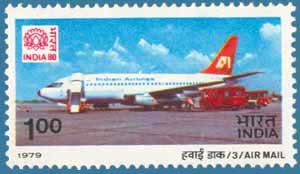Indian Airlines (Boeing 737)

The progression of mail delivery methods reflects humanity’s relentless pursuit of efficiency in communication. From the utilization of trained pigeons to the deployment of sophisticated satellites, each era has marked significant advancements in the speed and reach of message transmission.
In the early 20th century, the breakthrough achieved by the Wright Brothers in 1903 paved the way for monumental developments in aviation. Henri Piquret’s historic flight on February 18, 1911, from Allahabad to Naini Railway Station marked the world’s first instance of airborne mail delivery, orchestrated by the Indian Post & Telegraphs.
Following this landmark event, the establishment of the first regular airmail service in India in 1929 signified a new era in postal communication. J.R.D. Tata’s maiden flight in 1932 further propelled the expansion of air travel, connecting cities like Ahmedabad, Bombay, and Bellary.
Post-independence, the Government of India introduced the Night Airmail Service in 1949, revolutionizing mail delivery between major metropolitan cities. Shri Rafi Ahmed Kidwai’s visionary leadership played a pivotal role in the implementation of this scheme, which significantly enhanced the efficiency of mail transportation.
Today, Indian Airlines and Air India serve as vital conduits for domestic and international airmail delivery, respectively. The Indian Air Force has also played a crucial role in ferrying mail, demonstrating their dedication in both peacetime and wartime situations.
The evolution of mail delivery methods reflects not only technological advancements but also the unwavering commitment to improving communication efficiency. The issuance of commemorative stamps honoring those associated with airborne mail delivery serves as a testament to the importance of this aspect of India’s history.
